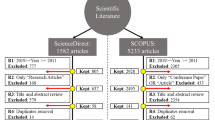Abstract
Manufacturing entities in a supply-chain network may face difficulties in coordinating themselves due to different organizational conventions, locally specific restrictions, and conflicting objectives. This paper focuses on the study of a collaborative decision paradigm for operational coordination among manufacturing facilities in manufacturing logistics network. The aim of this work is to propose a collaborative coordination mechanism that allows the distributed production system to perform just as well as a centralized one using the notion of collaborative agents. Two search methods incorporated in the coordination mechanism are investigated with various test scenarios under partial information sharing environment.
Similar content being viewed by others
References
Jeong IJ, Leon VJ (2002) Decision-making and cooperative interaction via coupling agents in organizationally distributed systems. IIE Transactions–Special Issue on Large-Scale Optimization 34:789–802
Danzig GB, Wolfe P (1961) The decomposition algorithm for linear programs. Econometirc 29:767–778
Roundy RD, Maxwell WL, Herer YT, Tayur SR, Getzler AW (1991) A price-directed approach to real-time scheduling of manufacturing operations. IIE Trans 23:149–160
Kutanoglu E, Wu SD (1999) On combinatorial auction and Lagrangian relaxation for distributed resource scheduling. IIE Trans 31:813–826
Bender JR (1962) Partitioning procedure for solving mixed variables programming problems. Numer Math 4:238–252
Davis R, Smith RG (1983) Negotiation as a metaphor for distributed problem solving. Artif Intell 20:63–109
Lin GY, Solberg JJ (1992) Integrated shop floor control using autonomous agents. IIE Trans 24:57–71
Bertsekas DP (1988) The auction algorithm: a distributed relaxation method for the assignment problem. Ann Oper Res 14:15–123
Bertsekas DP (1990) The auction algorithm for assignment and other network flow problems: a tutorial. Interfaces 20:133–149
Bhatnagar R, Chandra P (1993) Models for multi-plant coordination. Eur J Oper Res 67:141–160
Adams J, Balas E, Zawack D (1988) The shifting bottleneck procedure for job shop scheduling. Manage Sci 34(3):391–401
Glover F (1989) Tabu search–Part I. ORSA J Comput 1:190–206
Glover F (1990) Tabu search–Part II. ORSA J Comput 2:4–32
Kirkpatrick S, Gelatt CD, Vecchi MP (1983) Optimization by simulated annealing. Science 220:671–680
Glover F, Laguna M (1997) Tabu search. Kluwer Academic Publishers, Boulder, CO
Laguna M, Barnes JW, Glover F (1991) Tabu search methods for single machine scheduling problems. J Intell Manuf 2:63–74
Van Laarhoven PJM, Aarts EHL (1988) Simulated annealing: theory and application. D. Reidel Publishing Company, Holland
Matsuo H, Suh CJ, Sullivan RS (1989) A controlled search simulated annealing method for the single machine weighted tardiness problem. Ann Oper Res 21:85–108
Vakharia AJ, Chang Y (1990) A simulated annealing approach to scheduling a manufacturing cell. Nav Res Logist 30:559–577
Author information
Authors and Affiliations
Corresponding author
Rights and permissions
About this article
Cite this article
Shin, H.J. Collaborative production planning in a supply-chain network with partial information sharing. Int J Adv Manuf Technol 34, 981–987 (2007). https://doi.org/10.1007/s00170-006-0664-6
Received:
Accepted:
Published:
Issue Date:
DOI: https://doi.org/10.1007/s00170-006-0664-6




